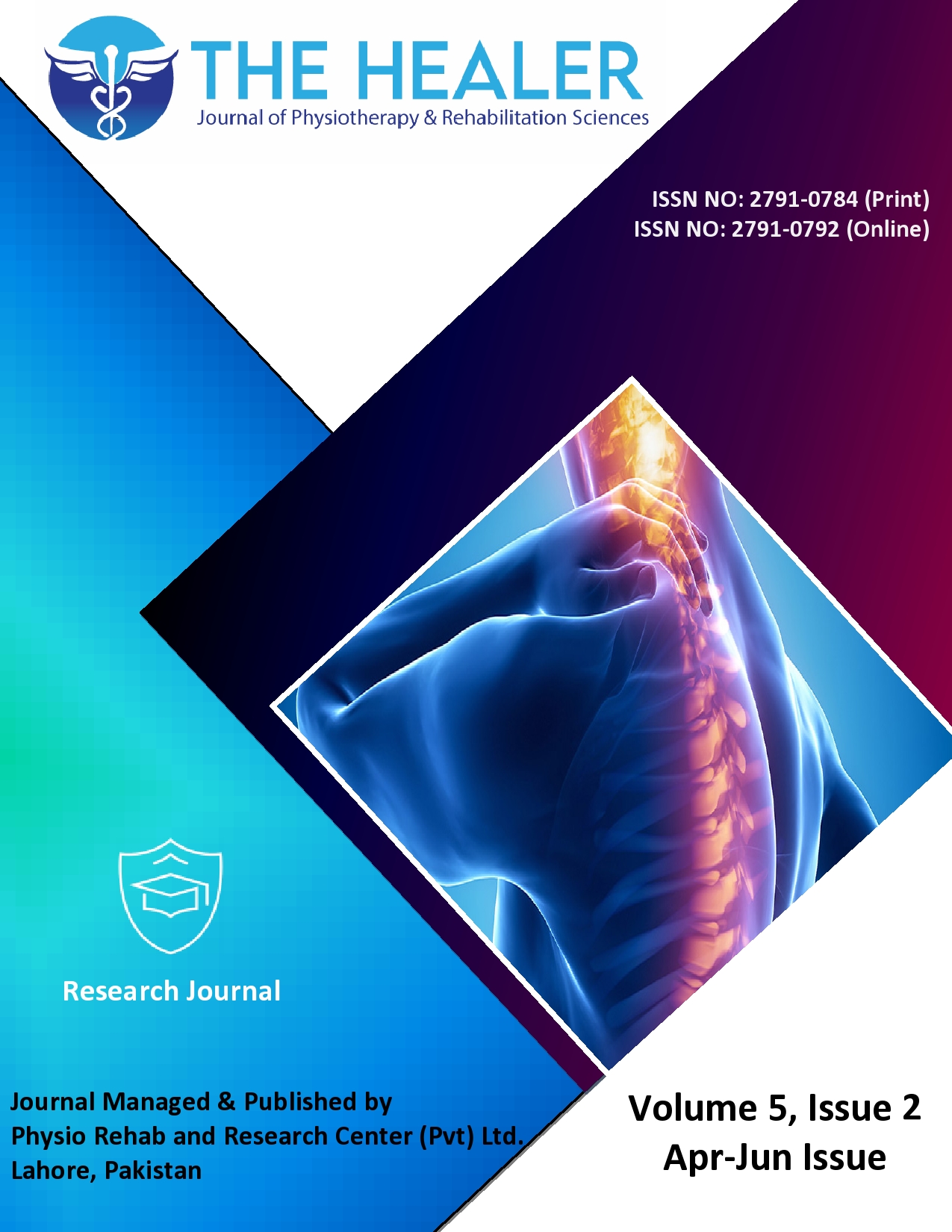Prevalence of Wrist Pain, Disability, and Association with Smartphone Addiction Among Undergraduate Physical Therapy Students of Hayatabad Peshawar; An Analytical Cross-Sectional Study
DOI:
https://doi.org/10.55735/1jqnrp03Keywords:
Musculoskeletal Pain , Physical Therapy , Smartphone Addiction , Wrist DisabilityAbstract
Background: In the modern world, smartphones have become an integral part of our daily life routine due to their extensive application in communication, entertainment, work, and study. However, excessive and prolonged use of smartphones has been linked to developing smartphone addiction, which in turn is a causative factor for many musculoskeletal problems, including wrist and hand pain as well as disabilities. Objective: To determine the prevalence of wrist pain, disability, and association with smartphone addiction among undergraduate physical therapy students of Hayatabad Peshawar. Methodology: A cross-sectional survey was conducted on 300 undergraduate physical therapy students of Hayatabad, Peshawar, using a convenience sampling technique. The nordic wrist pain scale, patient-rated wrist evaluation scale (PRWE), and smartphone addiction scale short version (SAS-SV) were used to determine the prevalence of wrist pain, its severity, and smartphone addiction level, respectively. Individuals with a history of wrist joint fracture or trauma, recent analgesic use, neurological, metabolic, and systemic diseases were excluded. The Shapiro-Wilk test was applied to assess the normality of the data for the continuous variable, which showed that our data was normally distributed (p>0.05). A chi-square test was performed to examine its association with wrist pain and disability. Results: Out of 300 students, 168(56%) showed a high level of smartphone addiction, whereas 132(44%) showed a low level of smartphone addiction. The prevalence of wrist pain was found to be 162(54%) out of 300; the majority of the participants fell into the mild category of wrist pain and disability. A significant association was found between smartphone addiction and wrist pain, disability (p=0.00). Wrist Pain and Duration of mobile phone usage were statistically significant (p=0.00), 55.7% of the participants used their mobile phones more than five hours a day. Conclusion: There was a high prevalence of smartphone addiction among students, which was associated with increased prevalence of wrist pain. The duration of smartphone usage was also significantly associated with wrist pain and disability.
Downloads
References
1. Ahmed S, Mishra A, Akter R, Shah MH, Sadia AA. Smartphone addiction and its impact on musculoskeletal pain in the neck, shoulder, elbow, and hand among college-going students: a cross-sectional study. Bulletin of Faculty of Physical Therapy 2022; 27(1): 5.
https://doi.org/10.1186/s43161-021-00067-3 DOI: https://doi.org/10.1186/s43161-021-00067-3
2. Mustafaoglu R, Yasaci Z, Zirek E, Griffiths MD, Ozdincler AR. The relationship between smartphone addiction and musculoskeletal pain prevalence among the young population: a cross-sectional study. The Korean Journal of Pain 2021; 34(1): 72-81.
https://doi.org/10.3344/kjp.2021.34.1.72 DOI: https://doi.org/10.3344/kjp.2021.34.1.72
3. Shah PP, Sheth MS. Correlation of smartphone use addiction with text neck syndrome and SMS thumb in physiotherapy students. International Journal of Community Medicine and Public Health 2018; 5(6): 2512.
https://doi.org/10.18203/2394-6040.ijcmph20182187 DOI: https://doi.org/10.18203/2394-6040.ijcmph20182187
4. Amiri M, Dowran B. Smartphone overuse from Iranian university students’ perspective: A qualitative study. Addiction & Health 2020; 12(3): 205.
https://doi.org/10.22122/ahj.v12i3.271
5. Kim SH, Kim YH, Lee C-H, Lee Y. Smartphone usage and overdependence risk among middle-aged and older adults: a cross-sectional study. BMC Public Health 2024; 24(1): 413.
https://doi.org/10.1186/s12889-024-17873-8 DOI: https://doi.org/10.1186/s12889-024-17873-8
6. Alageel AA, Alyahya RA, A. Bahatheq Y, et al. Smartphone addiction and associated factors among postgraduate students in an Arabic sample: a cross-sectional study. BMC Psychiatry 2021; 21(1): 302.
https://doi.org/10.1186/s12888-021-03285-0 DOI: https://doi.org/10.1186/s12888-021-03285-0
7. Al-Dhafer BAA, Alessa Sr HA, Albesher Sr MA, Alnaim MF, Albawardi SK, Albesher M. The Association Between Smartphone Addiction/Overuse With Hand and Wrist Musculoskeletal Complaints, Saudi Arabia. Cureus 2023; 15(11).
https://doi.org/10.7759/cureus.48752 DOI: https://doi.org/10.7759/cureus.48752
8. Altıparmak A, Arpacı MF, Aydın M, İnceoğlu F, Pekmez H. Investigation of the Effects of Smartphone Use on the Dominant Thumb and Wrist of University Students. Medical Records; 5(3): 523-31.
https://doi.org/10.37990/medr.1309585 DOI: https://doi.org/10.37990/medr.1309585
9. Eitivipart AC, Viriyarojanakul S, Redhead L. Musculoskeletal disorder and pain associated with smartphone use: A systematic review of biomechanical evidence. Hong Kong Physiotherapy Journal 2018; 38(2): 77-90.
https://doi.org/10.1142/S1013702518300010 DOI: https://doi.org/10.1142/S1013702518300010
10. Prasad M, Patthi B, Singla A, et al. Nomophobia: A cross-sectional study to assess mobile phone usage among dental students. Journal of Clinical and Diagnostic Research: JCDR 2017; 11(2): ZC34-ZC39.
https://doi.org/10.7860/JCDR/2017/20858.9341 DOI: https://doi.org/10.7860/JCDR/2017/20858.9341
11. Sirajudeen MS, Alzhrani M, Alanazi A, et al. Prevalence of upper limb musculoskeletal disorders and their association with smartphone addiction and smartphone usage among university students in the Kingdom of Saudi Arabia during the COVID-19 Pandemic: A Cross-Sectional Study. Healthcare 2022; 10(12): 2373.
https://doi.org/10.3390/healthcare10122373 DOI: https://doi.org/10.3390/healthcare10122373
12. Walankar PP, Kemkar M, Govekar A, Dhanwada A. Musculoskeletal pain and risk factors associated with smartphone use in university students. Indian Journal of Occupational and Environmental Medicine 2021; 25(4): 220-4.
https://doi.org/10.4103/ijoem.ijoem_351_20 DOI: https://doi.org/10.4103/ijoem.ijoem_351_20
13. Li S, Deng Y, Cai L, Wu L. The relationship between smartphone addiction and sleep disorder among college students: negative emotions as a mediator and gender as a moderator. Frontiers in Psychiatry 2025; 16: 1542243.
https://doi.org/10.3389/fpsyt.2025.1542243 DOI: https://doi.org/10.3389/fpsyt.2025.1542243
14. Banadaki FD, Rahimian B, Moraveji F, Varmazyar S. The impact of smartphone use duration and posture on the prevalence of hand pain among college students. BMC Musculoskeletal Disorders 2024; 25(1): 574.
https://doi.org/10.1186/s12891-024-07685-7 DOI: https://doi.org/10.1186/s12891-024-07685-7
15. Baabdullah A, Bokhary D, Kabli Y, Saggaf O, Daiwali M, Hamdi A. The association between smartphone addiction and thumb/wrist pain: A cross-sectional study. Medicine 2020; 99(10): e19124.
https://doi.org/10.1097/MD.0000000000019124 DOI: https://doi.org/10.1097/MD.0000000000019124
16. Neupane S, Ali U, Mathew A. Text neck syndrome: systematic review. Imperial Journal of Interdisciplinary Research 2017; 3(7): 141-8.
17. Parasuraman S, Sam AT, Yee SWK, Chuon BLC, Ren LY. Smartphone usage and increased risk of mobile phone addiction: A concurrent study. International Journal of Pharmaceutical Investigation 2017; 7(3): 125.
https://doi.org/10.4103/jphi.JPHI_56_17 DOI: https://doi.org/10.4103/jphi.JPHI_56_17
18. Amjad F, Farooq MN, Batool R, Irshad A. Frequency of wrist pain and its associated risk factors in students using mobile phones. Pakistan Journal of Medical Sciences 2020; 36(4): 746-9.
https://doi.org/10.12669/pjms.36.4.1797 DOI: https://doi.org/10.12669/pjms.36.4.1797
19. Hassaan MM, Jareebi MA, AlKaabi HA, et al. Prevalence of Thumb and Wrist Pain Among Smartphone Users in the Saudi Arabian General Population: A Cross-Sectional Study. Cureus 2024; 16(1): e52922.
https://doi.org/10.7759/cureus.52922 DOI: https://doi.org/10.7759/cureus.52922
20. Selvakumar K, Sheng LY. The prevalence and risk factors of wrist pain among young adults in UTAR during movement control order: a cross-sectional study. International Journal of Health Sciences and Research 2021; 11: 191-202.
https://doi.org/10.52403/ijhsr.20211125 DOI: https://doi.org/10.52403/ijhsr.20211125
21. Chen B, Liu F, Ding S, Ying X, Wang L, Wen Y. Gender differences in factors associated with smartphone addiction: a cross-sectional study among medical college students. BMC Psychiatry 2017; 17(341): 1-9.
https://doi.org/10.1186/s12888-017-1503-z DOI: https://doi.org/10.1186/s12888-017-1503-z
22. Bartwal J, Nath B. Evaluation of nomophobia among medical students using smartphone in north India. Medical Journal Armed Forces India 2020; 76(4): 451-5.
https://doi.org/10.1016/j.mjafi.2019.03.001 DOI: https://doi.org/10.1016/j.mjafi.2019.03.001
23. Khalid A, Ahmad J, Sarfraz R, Iqbal A, Arshad A, Zahid H. Prevalence of Musculoskeletal Pain Due to Smart Phone Usage Among High School Students-A Crosssectional Study: Musculoskeletal Pain due to Smart Phone usage. Pakistan Journal of Health Sciences 2022: 215-8.
https://doi.org/10.54393/pjhs.v3i07.425 DOI: https://doi.org/10.54393/pjhs.v3i07.425
24. Renuka K, Gopalakrishnan S, Umadevi R. Prevalence of smartphone addiction in an urban area of Kanchipuram district, Tamil Nadu: a cross sectional study. International Journal of Community Medicine and Public Health 2019; 6(10): 4218.
https://doi.org/10.18203/2394-6040.ijcmph20194166 DOI: https://doi.org/10.18203/2394-6040.ijcmph20194166
25. Alhassan AA, Alqadhib EM, Taha NW, Alahmari RA, Salam M, Almutairi AF. The relationship between addiction to smartphone usage and depression among adults: a cross sectional study. BMC Psychiatry 2018; 18: 1-8.
https://doi.org/10.1186/s12888-018-1745-4 DOI: https://doi.org/10.1186/s12888-018-1745-4

Downloads
Published
License
Copyright (c) 2025 The Healer Journal of Physiotherapy and Rehabilitation Sciences

This work is licensed under a Creative Commons Attribution 4.0 International License.














